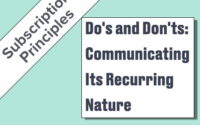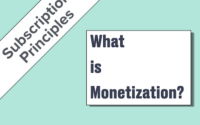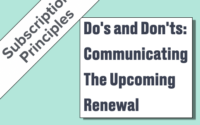Should I encourage my subscribers to use my service?
Summary
Encourage subscribers to use all benefits and features unless the marginal cost is high. Higher service usage leads to higher retention and upsell rates.📈
Merchants often wonder if they should
- encourage maximum subscription use, which may increase costs,
- or do nothing.
1. Risks
Let’s imagine these 2 examples of subscriptions:
- I offer a subscription to an ink cartridge service. What happens if my customers consume more ink than expected?
- I offer a subscription for access to a gym. What happens if all customers come at the same time?
Encouraging more usage can increase risk.
Financial risk: the marginal costs
The marginal cost of a subscriber is the cost of one more customer. Some businesses, like dating sites or video games, have almost zero marginal costs.
The marginal cost of the service is the cost generated by one more use by the customer. This cost varies:
- Virtually zero: an extra bus trip in a public transport subscription
- Negative: for a subscription to an theme park, the subscriber will spend on food and souvenirs, and therefore will bring back more than if he had not come
- Positive and Significant: when the subscription involves a physical product and/or shipping costs.
This risk should not exist or at worst should be very limited. Indeed, the price of subscriptions must have been calculated according to the cost of the service. In addition, we have ensured that the General Conditions of Sale include a supply limit calculated according to the marginal cost of the service.
The risk of customer dissatisfaction and inability to provide the service
Just as the customer has an obligation to pay, the merchant has an obligation to provide the service he has sold.
In the gym example, if all subscribers go to the gym at the same time, customers will not be satisfied. This situation does not necessarily reflect a failure of the merchant, nor an abuse of customers.
To avoid this risk, you must be careful to diversify the acquisition of new customers in order to streamline traffic. For example, if I sell a video streaming service, I will try to establish myself in several time zones or have an offer that covers several interests.
The risk with regulators
Regulators hunt for “subscription traps” and impose fines on companies that renew subscriptions when they know that customers are not using them.
From the moment we know that a customer is not using their subscription, we must inform them and encourage them to use it. Otherwise, we take a risk by renewing it.
2. Benefits
Increasing the retention rate
If I am in the situation where: The more customers use my service, the more my retention rate drops, then my service is not good. 👎
When the service satisfies, the retention rate can only improve. It’s generally observed that customers who use the service more often, or who use more features, have a higher retention rate than others.
Increasing the upgrade rate
The upgrade rate is a KPI that measures the percentage of customers who have changed their subscription plan for a higher offer.
It’s generally observed that customers using more features have a higher upgrade rate than others. As higher subscriptions are more expensive, this also increases the ASP (Average Selling Price) and booking in general.
👉 Key takeaways 👈
- Always encourage customers to use all subscription benefits. This boosts retention and upgrade rates.
- Anticipate and minimize risks through well-crafted Terms & Conditions.
- In a competitive market, a satisfying service is essential for long-term success.



